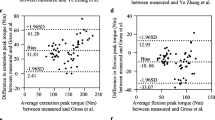Abstract
Isometric torque and the cross-sectional area (CSA) of the quadriceps femoris muscle (QF) were measured twice at an interval of 18 months in seven junior Olympic weight lifters (aged 15.5–17.1 years at the start of the study) to investigate the growth trend of this muscle group in junior athletes specializing in strength and power events. The CSAs of the QF and its four constituent muscles were determined at 30% (proximal to the knee), 50%, and 70% of femur length (Fl) using a magnetic resonance imaging method. Only at 30%Fl were significant increases found in the CSAs of the QF and all constituent muscles, except for the rectus femoris. At this level, the CSA of the vastus medialis relative to the QF decreased significantly, suggesting a predominant hypertrophy in the vastus intermedius and vastus lateralis muscles. Isometric torque during knee extension increased significantly compared, to the CSA for the QF measured at the three levels. Thus, the present results indicate that, at least at high school age, the QF for junior Olympic weight lifters is characterized by a preferential hypertrophy at the level proximal to the knee joint, with an increase in knee extension torque relative to the CSA.


Similar content being viewed by others
References
Aagaard P, Anderson JL, Dyhre-Poulsen P, Leffers A-M, Wanger A, Magnussen SP, Halkjaer-Kristensen J, Simonsen EB (2001) A mechanism for increased contractile strength of human pennate muscle in response to strength training: changes in muscle architecture. J Physiol (Lond) 534:613–623.
Alexander RM, Vernon A (1975) The dimensions of knee and ankle muscles and the forces they exert. J Hum Mov Stud 1:115–123
Alway SE, Stray-Gundersen J, Grumbt WH, Gonyea WJ (1990) Muscle cross-sectional area and torque in resistance-trained subjects. Eur J Appl Physiol 60:86–90
Asmussen E, Heebøll-Nielsen KR (1954) A dimensional analysis of physical performance and growth in boys. J Appl Physiol 7:593–603
Birrer RB, Levine R (1987) Performance parameters in children and adolescent athletes. Sports Med 4:211–227
Fukunaga T (1976) Die absolute muskelkraft und das muskelkrafttraining. Sportarzt Sportmed, 11:255–265
Garhammer J (1980) Power production by Olympic weightlifters. Med Sci Sports Exerc 12:54–60
Garhammer J (1991) A comparison of maximal power outputs between elite male and female weightlifters in competition. Int J Biomech 7:3–11
Garhammer J (1993) A review of power output of Olympic and powerlifting: methodology, performance prediction, and evaluation tests. J Strength Cond Res 7:76–89
Häkkinen K, Mero A, Hauhanen H (1989) Specificity of endurance, sprint and strength on physical perfromance capacity in young athletes. J Sports Med Phys Fitness 29:27–35
Housh DJ, Housh TJ, Johnson GO, Chu W-K (1992) Hypertrophy response to unilateral isokinetic resistance training. J Appl Physiol 73:65–70
Kanehisa H, Fukunaga T (1999) Velocity associated characteristics of force production in college weight lifters. Br J Sports Med 33:113–116
Kanehisa H, Ikegawa S, Tsunoda N, Fukunaga T (1994) Cross-sectional areas of fat and muscle in limbs during growth and middle age. Int J Sports Med 15:420–425
Kanehisa H, Ikegawa S, Tsunoda N, Fukunaga T (1995) Strength and cross-sectional areas of reciprocal muscle groups in the upper arm and thigh during adolescence. Int J Sports Med 16:54–60
Kawakami Y, Abe T, Kuno S, Fukunaga T (1995) Training induced changes in muscle architecture and specific tension. Eur J Appl Physiol 72:37–43
Malina RM (1994) Physical activity and training: effects on stature and the adolescent growth spurt. Med Sci Sports Exerc 26:759–766
Martin JC, Farrar RP, Wangner BM, Spirduso WW (2000) Maximal power across the lifespan. J Gerontol A Biol Med Sci 55:M311–316
Moss BM, Refnes PE, Ablidgaard A, Nicolaysen K, Jensen J (1997) Effects of maximal effort strength training with different loads on dynamic strength, cross-sectional area, load-power and load-velocity relationships. Eur J Appl Physiol 75:193–199
Narici MV, Roi GS, Landoni L, Minetti AE, Cerretelli P (1989) Changes in force, cross-sectional area and neural activation during strength training and detraining of the human quadriceps. Eur J Appl Physiol 59:310–319
Narici MV, Hoppeler H, Kayser B, Landoni L, Claassen H, Gavardi C, Conti M, Cerretelli P (1996) Human quadriceps cross-sectional area, torque and neural activation during 6 months strength training. Acta Physiol Scand 157:175–186
Saavedra C, Lagasse P, Bouchard C, Simoneau J-A (1991) Maximal anaerobic performance of the knee extensor muscles during growth. Med Sci Sports Exerc 23:1083–1089
Sale DG (1988) Neural adaptation to resistance training. Med Sci Sports Exerc 20:S135-S145
Sale DG, MacDougall JD, Alway SE, Sutton JR (1987) Voluntary strength and muscle characteristics in untrained men and women and male bodybuilders. J Appl Physiol 62:1786–1793
Schmidtbleicher D, Buehrle M (1987) Neural adaptation and increase of cross-sectional area studying different strength training methods. In: Jonsson B (ed) Biomechanics X-B. Human Kinetics, Champaign, Ill, pp 615–620
Schmidtbleicher D, Haralambie G (1981) Changes in contractile properties of muscle after strength training in man. Eur J Appl Physiol 46:221–228
Tanner JM, Hughes PCR, Whitehouse RH (1981) Radiographically determined widths of bone, muscle and fat in the upper arm and calf from age 3–18 years. Ann Hum Biol 8:495–517
Tanner JM, Whitehouse RH, Marshall WA, Healy MJR, Goldstein H (1983) Assessment of skeletal maturity and prediction of adult height. 2nd edn. Academic Press, New York
Acknowledgements
This study was supported by financial aids from the Japan Amateur Sports Association. We thank Dr. Mitsunori Murata for the data analysis of skeletal age.
Author information
Authors and Affiliations
Corresponding author
Rights and permissions
About this article
Cite this article
Kanehisa, H., Funato, K., Kuno, S. et al. Growth trend of the quadriceps femoris muscle in junior Olympic weight lifters: an 18-month follow-up survey. Eur J Appl Physiol 89, 238–242 (2003). https://doi.org/10.1007/s00421-003-0802-x
Accepted:
Published:
Issue Date:
DOI: https://doi.org/10.1007/s00421-003-0802-x




